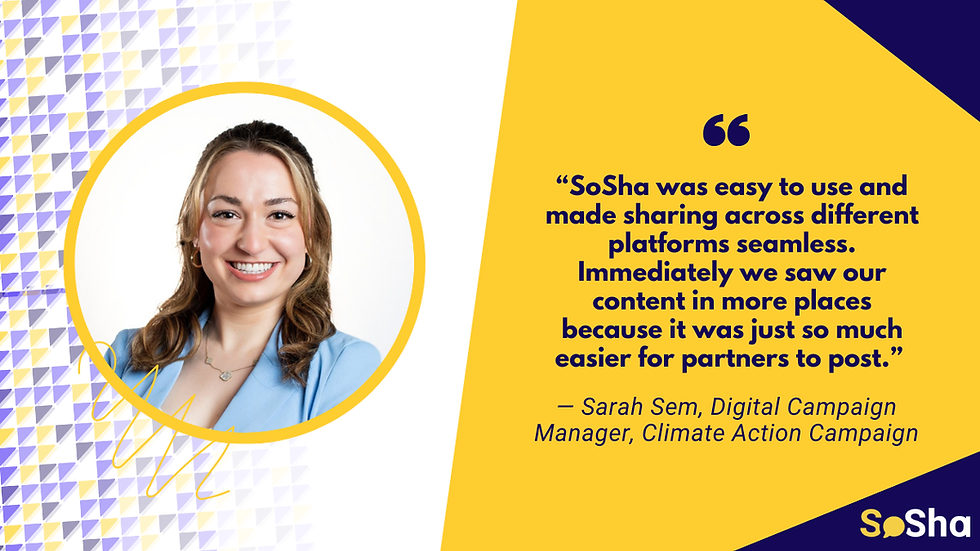People-Powered Fundraising: 5 Takeaways from NC State’s Day of Giving for End-of-Year Fundraisers
- SoSha Staff

- Oct 28
- 4 min read
In March 2025, North Carolina State University (NC State) raised over $50.56 million from 18,565 individual gifts in a single day. Their Day of Giving wasn’t just a big fundraising push—it was a relational, community-led movement rooted in authenticity, joy, and trust.
For fundraising professionals preparing for Giving Tuesday and year-end campaigns, NC State’s approach offers five powerful lessons grounded in shared leadership, accessible storytelling, and scalable tools.
1. Invite People Into the Movement — Don’t Just Ask Them to Give
Fundraising isn’t just about dollars. It’s about inviting people to bring their skills, relationships, and passion to the causes they care about.
NC State activated around 500 ambassadors—known as “Pack Leaders”—to help promote the campaign online. These Pack Leaders weren’t just messengers—they were organizers. Each ambassador brought their own network into the fold, sharing why they give and asking others to join them. Instead of relying exclusively on conveying urgency, the Pack Leaders made relational asks that said: “Join me in supporting something that matters.”
Takeaway: Design your giving campaign as an invitation to participate, not a transaction. Equip supporters with ways to take ownership and share why the work matters to them. SoSha provides organizations the tools to enable supporters to share why they care about the fundraiser and why others should participate.
2. Make It Easy — and Fun — to Fundraise
Too often, volunteer-led fundraising is hindered by unclear direction from multiple messaging sources or high barriers to entry for content creation. NC State tackled this by providing customizable social media toolkits through SoSha’s platform. These included:
Prewritten, modifiable posts
Selfie overlays and video frames
Individual UTM tracking links
Live challenge updates and engagement prompts
These toolkits helped spark supporter creativity. It allowed Pack Leaders to post quickly, personalize their asks, and even have fun with it—without having to be “extroverted bundlers” or event hosts. And the results were real: 932 unique social posts and 259,961 impressions helped drive traffic and dollars back to NC State.
Takeaway: Fundraising can be joyful and expressive. Provide room for supporters to customize messaging and assets that empower creativity, playfulness, and authenticity—while still tying their actions to tangible outcomes.
3. Structure Your Campaign Around Momentum and Micro-Wins
The 2025 Day of Giving wasn’t one long push—it was a cycle of planning, doing, and reflecting in real time. NC State’s campaign used hour-by-hour giving challenges like “Most Young Alumni Gifts” or “Most Parent & Family Gifts” to spark bursts of energy and create friendly competition across their community.
This kind of momentum matters. It helped volunteers stay engaged throughout the day and gave them reasons to reach out again and again. And it created visible moments of success and celebration across the campaign.
Takeaway: Build your campaign around moments that reward action and generate energy. Don’t just set a goal—set a rhythm. SoSha enables teams to create and deploy toolkits in minutes, meaning your messaging remains current even during time-critical campaigns.
4. Track Results to Grow Organizing Capacity — Not Just Performance
With SoSha’s built-in tracking links, NC State was able to see which volunteers were generating clicks and conversions, what content performed best, and where engagement came from. But this wasn’t just a performance audit—it was a way to understand and deepen community leadership.
Knowing which Pack Leaders were most effective let the team celebrate wins, share templates, and build donor organizing capacity—a core tenet of movement fundraising. That learning can now inform how NC State trains, supports, and expands its ambassador base year after year.
Takeaway: Data should drive reflection, not just reporting. Use what you learn to grow leadership, refine your playbook, and share power more broadly next time around.
5. Close the Loop — and Build for the Long Term
A standout moment in NC State’s campaign came after the fundraising day ended. Using SoSha, the team sent real-time impact updates showing how donations were already being applied to student support, scholarships, and college programs.
That transparency helps build trust and lays the foundation for deeper donor relationships. But more than that, it signals that your movement is powered by people—and accountable to them.
Takeaway: Don’t treat fundraising like a one-day transaction – even during single days of action. Reflect back the impact, show donors where their gifts went, and invite them to keep growing with you.
The Bottom Line: People Power Scales
NC State’s 2025 Day of Giving succeeded not just because of dollars raised—but because it brought more people, more relationships, and more meaning into the process.
For fundraisers planning Giving Tuesday or year-end campaigns, this case study is a reminder that the most sustainable support doesn’t come from the loudest asks or the biggest checks—it comes from shared purpose, authentic leadership, and the infrastructure to let others lead.
So as you plan your next campaign, ask yourself:
Are we offering people a role in the work?
Are we making participation easy, expressive, and personal?
Are we learning from, reflecting on, and growing our communities —not just numbers?
📌 Looking for SoSha solutions for small-dollar fundraisers? Check out this article walking through how to adapt these strategies for smaller-scale, lower-threshold campaigns.
Written by Michael Roach.


